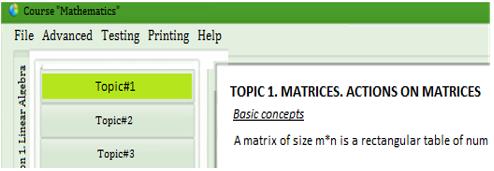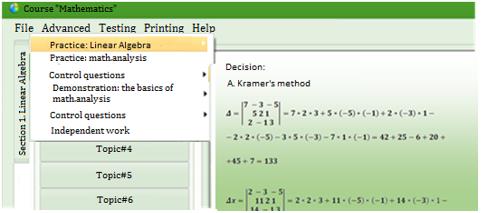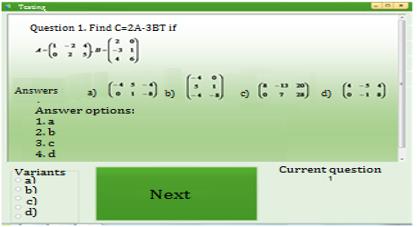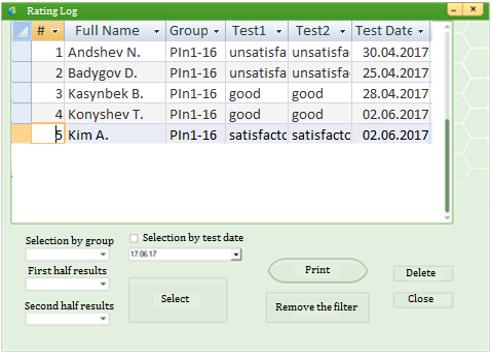Abstract
Regular inventions and development in all areas of information technology provide new ways and opportunities for progress in teaching and education methods. They can improve teachers’ skills to present information interactively if compared to conventional methods. This method can help students by providing them information through channels and methods that may be easier for comprehension, processing, and searching/retrieving. The aim of the study is to formulate an applied implementation of student professional competence development in vocational training by means of multimedia technologies a case study of mathematical subjects. The shell software is designed in Borland Delphi 7 development environment. While embodying the training system, theoretical and data-aware and developmental methods are used. The paper reports on an approach to teaching mathematics courses by integrating significant multimedia technologies into the learning process. It is found out that multimedia technology applied in teaching mathematics within the higher education curriculum is a way to enhance the effectiveness of using information technologies in learning activities. The findings show that the appropriate involvement of an animated effect in the resources can assist cognitive processes that focus on selecting information, producing presentation models, and reasoning, thereby contributing to studying capacity. The application of the developed software improves student professional engagement.
Keywords: Multimedia technologies, learning experiences, mathematics, multimedia learning system, competence
Introduction
One of the most important objectives of the Development Concept of Education in the Kyrgyz Republic (Kyrgyzstan) for 2012/2020 is to use new opportunities for educational information technologies in learning. The use of up-to-date information technologies in learning experiences allows one to arrange training promising and dynamic and makes a vast data flow studied more available.
The introduction of electronic resources into teaching and learning activities, including multimedia learning system (MMLS), makes the studies more intense, gives opportunities for individualization of learning, promotes the visual aids’ illustrative purpose, combines theoretical skills with hands-on experience, increases and keeps up students’ learning motivation. The declared issue is reviewed in many studies.
Vagg et al. (2020) studied medical students’ attitude to the use of various multimedia learning tools. Malhotra and Verma examined (2020) the ways of applying multimedia presentation attributes and therefore used for engineering educational objectives. Park et al. (2019) argued that multimedia technologies have a positive impact on the user’s perception of learning convenience, followed by a better adoption of multimedia technologies for learning.
The results of the study by Mutlu-Bayraktar et al. (2019) showed that most part of the cognitive load studies conducted so far in the multi-media based learning environment used STEM subjects.
Educators often use multimedia technologies when teaching their subjects on purpose. Yohannes et al. (2016) described an approach to teaching mathematics courses integrating meaningful multimedia technologies to stimulate the learning activities. Jian-hua (2012) studied the effective combination of University physics and multimedia used to optimize teaching physics as a basic elementary college course.
Zhang (2012) proved that the use of multimedia technologies in education allows teachers to model the final results and help students apply the knowledge absorbed from textbooks, thereby compensating for the shortage of conventional teaching methods. Kolmanič et al. (2013) presented a SIN multimedia training tool, which was developed for the computer-assisted theoretical knowledge transmission during fire guide training, where emergency response was visualized in a student-friendly environment.
Problem Statement
The problem of teaching and learning mathematics can be regarded as a series of issues, such as of regular method admission, the lack of a teacher’s creativity, and complex illustrations (Pardimin et al., 2018).
The present-day technological systems have opened up a world of opportunities for educators at all levels and in all fields. This research concerns the part that technological resources can take in encouraging or promoting the cognitive processes that make understanding and learning possible. In particular, they are supposed to explore within the cognitive theory of multimedia learning and the cognitive load theory (Mayer & Moreno, 2002), the advantages of minor adaptions to multimedia resources. In this case, applying an animated effect to a handwritten text referred to mathematics can be an excessive and too high quality of training (Öksüz et al., 2009).
The article suggests a teaching aid as represented by mathematics Multimedia Learning System (Atkinson, 2005) as a way to make student professional competence more effective.
Research Questions
When designing MMLS in mathematics, it is necessary to take into account the importance of this subject when students study general professional and specific courses. Mathematics is considered to be the basis of scientific knowledge in technical university as it allows students to gain insight into different kinds of the Natural Sciences and solve their problems, and cognize a specific character of common laws or patterns (Semenova, 2007).
The study describes MMLS software intended for teaching students mathematics. It is generated according to the didactic principles of selecting the content of educational materials. These are purposeful nature, scientific character, intelligibility, regular character and consistency throughout (arrangement of ideas for presentation) (Atkinson, 2005). The program has a simple and user-friendly interface. It makes training more effective and advanced navigation system for quick access to the content involved.
Purpose of the Study
The research aims at embodying the method of mastering student professional competencies that go into professional higher education through multimedia technologies and supported by the resources on the subjects related to mathematics.
Research Methods
The software shell was designed using Borland Delphi 7 environment.
When designing the presentation of the aids content in the system, the authors used academic and information and developmental methods. Theoretical methods comprised formal characterization, induction, and deduction. The authors selected those methods among information and developmental ones that let students receive educational information ‘out-of-the-box’. These are a teacher’s presentation (a lecture, a story, an explanation, a conversation); the speaker’s presentation (educational video); self-controlled reading of the textbook through the training software (programmed learning) (Semushina & Yaroshenko, 2001).
The pedagogical experiment on testing was held in the 2016/2017 academic year. 22 students majored in Applied mathematics and Computer science and 16 Software engineering students from the Kyrgyz State University of Construction, Transport and Architecture n.a. N. Isanov participated in the study. Five lecturers of mathematics from various universities also took part in testing the software.]
Findings
To embody the content of the software system, the authors chose a University mathematics course that includes Linear algebra and Elementary mathematical analysis sections.
The components of the system are interconnected and located in a common shell. The multimedia learning system covers several modules:
- a theoretical module that contains lectures on the course units;
- a presentation module, where the topics are displayed graphically;
- a module of hand-on activities for solving the course problems, to perfect the content studied;
- a module of test questions and self-study for each section.
The designed shell implements technology for preparing various types of tests. A student can check the progress level of the content studied individually with the tests. Therefore, there is constant feedback provided in this way. It can increase personal learning skill achievement. The testing system of the software allows an educator to evaluate the correctness of the student’s answers to the questions suggested. After testing had been completed, information about the results was provided. To avoid the possibility to remember correct answers, the authors used a database of assignments, where the options are randomized and taken as an acceptance sampling.
The theoretical module includes topics that correspond to the syllabi and curricula composed according to the State Educational Standard of Higher Education in the Kyrgyz Republic. The demo part was addressed to the high-quality interpretation of the topics discussed.
During the study, the authors selected practical multi-level and multi-choice tasks and demonstrations/showcases for each topic.
When developing the interface of a multimedia learning system, the authors were guided by the principle of simplicity and operation comfort of the program. A user who logged in as an administrator could view the rating log and the group table. To get to know the theoretical materials of the course, a user selects the topic from the suggested sections in the main menu (Figure 1).

A visual representation of the theoretical material on the selected topics can be clicked on the menu item Advanced tab → Demonstrations (Figure 2a). After the selection, a visual representation of the topic appears on the screen (Figure 2b).

After studying the theoretical material, a student can get to practice using the Practice command in the Advanced menu (Figure 3).

A student who had studied the theoretical material could take a test, where a database of randomly selected 20 out of 50 questions for each examinee was offered (Figure 4).

After passing the test, a tester posted grades according to on a five-point scale. The scores entered in the records. The Assessment Log/Records form is available for an educator or administrator only (Figure 5).

The illustrating part of the software in Linear algebra and Elementary mathematical analysis sections is made up of elements of computer-generated imagery. It helps students to master the missing material individually, perform practical activities and get prepared for the class, report, or exam effectively. If a student does not understand any part of the training content, he/she can revise that fragment. Reproduction of the training content for many times allows one to implement the tutoring mode of this module, which is used for individualization of learning. Step-by-step presentation of solutions for typical problems is one of the most important stages of training: it forms students’ knowledge - acquires new theoretical knowledge, new techniques and methods for solving problems. The content of this module implements the methodological component of developing professional direction of teaching mathematics at a higher level than with traditional teaching technologies, due to software capabilities, audio support, interactivity, and organization of tutoring mode without a teacher’s participation.
During the pedagogical experiment, the authors determined average scores in groups before and after applying MMLS in mathematics. Before applying it, the average score of applied mathematics students was 3 points and 4.1 points after using it. Before applying the system, the average score of Software engineering students was 2.8 points and 3.8 points with it. The authors emphasize the number of those students who achieved top marks increased by 36.6% and others by 35.7%.
A more detailed observation showed that there were significant positive changes in the components of professional competence. These were the ability to use mathematical Sciences in solving professional problems; the ability to perceive, generalize and analyze information, set a goal and choose ways to achieve it; the ability to acquire new scientific and professional knowledge using present-day educational and information technologies.
The survey of students proved a positive attitude to the program as convenient – 60%; the interface is quite good - 77%; the content is easy to learn - 92%; it helps in learning the content - 86%; hand-on tasks are difficult - 78%.
The authors surveyed educators who teach linear algebra and mathematical analysis. The results are shown in Table 1.
It could be seen from the responses that educators took a favorable view of the designed MMLS.
Conclusion
Multimedia Learning System develops students’ skills in setting and solving mathematical problems. Its use as a learning tool lets one treat academic interaction between students and instructors in a new manner. It also allows each student to live up to their intelligent potential as much as possible.
The usefulness of the software is that it can be used not only to inform on facts supplied with visual aids but also to illustrate particular processes that cannot be presented using standard teaching techniques.
Multimedia Learning System can be successfully integrated with learning, and hence it will enhance the skills and call for an advanced learning differentiation.
References
Atkinson, R. K. (2005). Multimedia learning of mathematics. In R. Mayer (Ed.), The Cambridge handbook of multimedia learning (pp. 393-408). Cambridge University Press.
Jian-hua, S. (2012). Explore the effective use of multimedia technology in college physics teaching. Energy Procedia, 17, 1897-1900.
Kolmanič, S., Guid, N., & Nerat, A. (2013). SIN: Multimedia-based teaching tool for computer-supported fire-fighter training. Fire Safety Journal, 61, 26-35.
Malhotra, R., & Verma, N. (2020). An impact of using multimedia presentations on engineering education. Procedia Computer Science, 172, 71-76.
Mayer, R. E., & Moreno, R. (2002). Animation as an aid to multimedia learning. Educational psychology review, 14(1), 87-99.
Mutlu-Bayraktar, D., Cosgun, V., & Altan, T. (2019). Cognitive load in multimedia learning environments: A systematic review. Computers & Education, 141, 103618.
Öksüz, C., Uça, S., & Genç, G. (2009). Designing multimedia videocases to improve mathematics teaching with technology: “technology integration into mathematics education” project. Procedia-Social and Behavioral Sciences, 1(1), 489-494.
Pardimin, A., Ninsiana, W., Dacholfany, M. I., Kamar, K., Teh, K. S. M., Huda, M., Hananto, A. L., Muslihudin, M., Shankar, K., Kamenez, N. V., & Maseleno, A. (2018). Developing multimedia application model for basic mathematics learning. Journal of Advanced Research in Dynamical and Control Systems, 10(14), 1347-1356.
Park, C., Kim, D. G., Cho, S., & Han, H. J. (2019). Adoption of multimedia technology for learning and gender difference. Computers in Human Behavior, 92, 288-296.
Semenova, N. G. (2007). Teoreticheskie osnovy sozdaniya i primeneniya mul'timediynykh obuchayushchikh sistem lektsionnykh kursov elektrotekhnicheskikh distsiplin [Theoretical bases of creation and application of multimedia training systems of lecture courses of electro technical disciplines]. Vestnik. [in Russ.]
Semushina, L. G., & Yaroshenko, N. G. (2001). Soderzhanie i tekhnologiya obucheniya v srednikh spetsial'nykh uchebnykh zavedeniyakh [Content and technology of teaching in secondary specialized educational institutions]. Masterstvo. [in Russ.]
Vagg, T., Balta, J. Y., Bolger, A., & Lone, M. (2020). Multimedia in education: what do the students think? Health Professions Education, 6(3), 325-333.
Yohannes, H. M. G., Bhatti, A. H., & Hasan, R. (2016). Impact of multimedia in Teaching Mathematics. International Journal of Mathematics Trends and Technology, 39(1), 80-83.
Zhang, F. (2012). Significances of multimedia technologies training. Physics Procedia, 33, 2005-2010.
Copyright information

This work is licensed under a Creative Commons Attribution-NonCommercial-NoDerivatives 4.0 International License.
About this article
Publication Date
21 June 2021
Article Doi
eBook ISBN
978-1-80296-110-2
Publisher
European Publisher
Volume
111
Print ISBN (optional)
-
Edition Number
1st Edition
Pages
1-1168
Subjects
Social sciences, education and psychology, technology and education, economics and law, interdisciplinary sciences
Cite this article as:
Dzhaparova, S., Mukambetova, S., Isabekov, K., & Bazhenov, R. (2021). Multimedia Learning System In Mathematics As A Student Professional Competence Forming Technique. In N. G. Bogachenko (Ed.), Amurcon 2020: International Scientific Conference, vol 111. European Proceedings of Social and Behavioural Sciences (pp. 111-118). European Publisher. https://doi.org/10.15405/epsbs.2021.06.03.15

